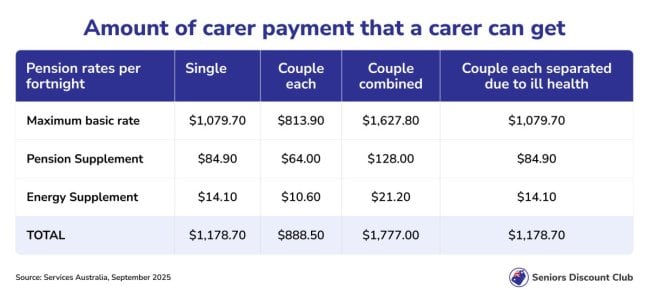
If you're one of Australia's 2.65 million unpaid carers, there's some welcome news from Centrelink that could make a real difference to your hip pocket.
In total, around 3 million Australians care for someone with disability, illness or frailty, and remarkably almost 400,000 of them are aged under 25—students and young adults stepping up as carers.
Changes to the Carer Payment rules mean you can now work more hours without fear of losing your vital support payments.
This shift couldn't come at a better time. With the cost of living biting hard, many carers have been caught between a rock and a hard place—wanting to earn extra income but worried about breaching Centrelink's strict limits. The old system was inflexible and often penalised carers who took on a few extra shifts to make ends meet.
In this article
What's Changed with Carer Payments?
Starting from 20 September 2025, Centrelink has overhauled how they assess work hours for Carer Payment recipients. The biggest change? Carers can now work up to 100 hours over a rolling 4-week period, replacing the old rigid limit of 25 hours per week, according to Hank Jogen, General Manager of Services Australia.
The reform builds on a $18.6 million Federal Budget package announced in May 2024 to remove employment barriers for carers and improve workforce flexibility.
Key Changes at a Glance
- Old limit: Maximum 25 hours per week, no exceptions
- New limit: Up to 100 hours over any 4-week period
- More flexibility to work longer hours some weeks
- Better suited to casual and irregular work patterns
This means if a carer needs to pick up extra shifts during school holidays or help out during busy periods at work, they won't automatically lose their payment. As long as their total hours over four weeks don't exceed 100, they're in the clear.

Who Benefits from These Changes?
The new rules are particularly helpful for carers in casual employment or those with fluctuating work schedules. Let's say you're caring for your elderly sister but also work at the local shops. Under the old system, if you worked 26 hours in one week to cover for a sick colleague, you'd risk losing your entire Carer Payment.
Example Scenario
- Sarah from Brisbane cares for her husband with MS while working casually as a nurse's aide. Some weeks she gets no shifts, others she's offered 30+ hours. The new system lets her accept work when it's available without constantly worrying about the 25-hour limit.
- Michael in Perth looks after his teenage son with autism. He does freelance IT work that's project-based. Now he can take on bigger projects that might require 40 hours one week and none the next, staying within the 100-hour monthly limit.
Current Carer Payment Rates
As of October 2025, Carer Payment provides the same rate as the Age Pension. If you're wondering what you're entitled to, here's the current breakdown:
Carer Payment Rates (from 20 September 2025)
Single: $1,144.40 per fortnight
Couple (each): $862.00 per fortnight
Couple (combined): $1,724.00 per fortnight
Plus Energy Supplement and other allowances if eligible
Remember, Carer Payment is different from Carer Allowance, which is an additional $153.50 per fortnight that you can receive on top of wages or other income support payments.
Understanding the Income Test
While the work hours have become more flexible, the income test for Carer Payment remains in place. You can earn up to $212 per fortnight (singles) or $372 per fortnight (couples combined) before your payment starts reducing.
Important: The income test and work test are separate. You must pass both to remain eligible for Carer Payment. This means even if you stay under 100 hours over 4 weeks, earning too much could still affect your payment.
Did you know?
Did you know?
Many carers don't realise they can receive both Carer Payment and Carer Allowance. Carer Allowance isn't income or assets tested, so if you're providing daily care to someone, it's worth applying even if you work full-time.
Other Support Available for Carers
Beyond the payment changes, there's a range of support services many carers don't know about:
- Carer Gateway: Free coaching, counselling, and respite services. Call 1800 422 737
- Companion Card: Free entry for carers at participating venues when accompanying the person they care for
- National Disability Insurance Scheme (NDIS): May fund support services, giving you more time for paid work
- My Aged Care: Can arrange respite care for elderly people you're caring for
Tips for Managing Your Work Hours
Making the most of the new flexibility requires some planning. Here's how to stay on the right side of Centrelink's rules:
Smart Strategies for Working Carers
Keep a diary or use an app to track your hours
Calculate your 4-week rolling total before accepting extra shifts
Inform Centrelink promptly if your circumstances change
Consider spreading work across weeks rather than concentrating it
'The new rules recognise that caring responsibilities don't always fit neatly into a Monday-to-Friday schedule. This flexibility helps carers maintain their connection to the workforce while providing essential care.'
What If You Exceed the Limit?
Mistakes happen, and Centrelink understands that. If you accidentally work more than 100 hours in a 4-week period:
- Contact Centrelink immediately
- Explain the circumstances
- You may be able to use one of your 'temporary cessation of care' days
- Your payment might be suspended rather than cancelled
- You can usually restart payments once you're back under the limit
If carers work or earn beyond the limits and cannot use respite days, their payment will now be suspended for six months instead of being cancelled entirely—a major policy improvement introduced with the March 2025 reforms.
Remember: Honesty is always the best policy with Centrelink. It's far better to report changes promptly than face potential overpayment debts later.
Planning for the Future
These changes to Carer Payment are part of broader reforms recognising the vital role carers play in our community. With an ageing population, the number of Australians needing care is only going to increase.
Caring in Australia—The Numbers
- 1 in 9 Australians are unpaid carers
- Carers provide 2.2 billion hours of unpaid care annually
- The replacement value of this care is $77.9 billion per year
- 72 per cent of primary carers are women
According to Services Australia General Manager David Hazlehurst, the changes ‘help carers stay connected to work and study while continuing their vital role supporting loved ones’.
Frequently Asked Questions
Can I study while receiving Carer Payment?
Yes! The new rules also apply a 100-hour limit over 4 weeks to study and training activities. This opens up opportunities for carers to upskill or retrain.
What if I care for more than one person?
You can only receive one Carer Payment, but you may be eligible for multiple Carer Allowance payments—one for each person you care for.
Do volunteer hours count towards the limit?
No, voluntary work doesn't count towards your 100-hour limit, giving you freedom to contribute to your community.
Did you know?
Hot tip:
If you're approaching pension age while receiving Carer Payment, you don't need to apply for the Age Pension. Centrelink will automatically transfer you when you reach pension age, ensuring no gap in payments.
Making It Work for You
The new Carer Payment rules offer a lifeline for many Australian families juggling care responsibilities with the need to earn income. Whether you're caring for an ageing parent, a partner with disability, or a child with additional needs, these changes provide more options to maintain your financial stability.
The key is understanding how to use this flexibility wisely. Keep good records, communicate with your employer about your caring responsibilities, and don't be afraid to access the support services available.
What This Means For You
These changes to Carer Payment represent a significant step forward in supporting Australia's army of unpaid carers. The move from a rigid weekly limit to a flexible monthly arrangement acknowledges the reality of modern caring arrangements and work patterns.
If you're currently receiving Carer Payment or thinking about applying, now's the time to review your situation. Could you pick up some casual work? Perhaps return to study? Or simply have the peace of mind that working an extra shift won't jeopardise your payment?
Take action today: Contact Centrelink on 132 717 to discuss how these changes might benefit your situation. Visit the servicesaustralia.gov.au website for more information, or call Carer Gateway on 1800 422 737 for support services. Remember, you're not alone in your caring journey—help is available, and these new rules are designed to make your life just that little bit easier.







